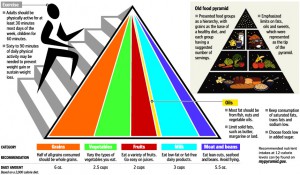 Recently, the U.S. Department of Agriculture unveiled a new food pyramid, now called MyPlate.
Recently, the U.S. Department of Agriculture unveiled a new food pyramid, now called MyPlate.
It’s simple, it’s informative and people can understand it without studying it. Here is the key: This simple image gives people practical information that anyone can use without extra explanation. With the way it’s designed, you can visually estimate how much of each type of food you should be eating just by looking at your plate.
The old pyramid wasn’t so practical. It took a lot to explain how to apply it. What good is telling people how many ounces of meat that they should have when they don’t know what that looks like in a real meal?
 In church communication we often do the same thing. We can get caught up in dumping information or trying to inspire a call to action, we forget the basic explanation and context.
In church communication we often do the same thing. We can get caught up in dumping information or trying to inspire a call to action, we forget the basic explanation and context.
Is your message functional…
- On your church sign? It’s become a popular blog topic that we have covered in the past but not being functional can make for some really bad church signs. Take the quote, “Faith smells the fragrance when as yet there is no rose.” When used on a church street sign, what most people read as they are driving by is “Faith Smells”.
- On your property? Ever gone to an important meeting and not known which room it was in? Ever need to go to the bathroom and couldn’t find it in a maze of hallways? For new attendees, especially non-Christians, going to church for the first time can be a nerve-wrecking experience. Finding the entrance, locations of children programs and even bathrooms should be obvious and easy. Some churches offer maps, but require you to be in the church to get one. A couple of signs that are easy to see can make your property functional. This is one of the first impressions you leave on a newcomer, why not make it easy and inviting?
- On all materials distributed outside of church grounds? If you’re promoting a sermon series, event or the church in general, the materials have to make sense and need no other explanation. This is where paying attention to language comes in. You won’t be there to explain where the church is, give the details of what a revival is or give reasons to why it applies to them. Keep your message simple, with all the facts that everyone would need to understand and do your call to action.
- When using scripture in social media? This is one of my pet peeves. Social media is used to reach people, and chances not everyone is an “advanced” Christian who understands the context and meaning to every scripture. There are a lot of amazing Bible passages out there that just don’t make sense when read by themselves on Twitter or Facebook. If you are going to put information out to educate and inspire, make sure it can stand alone. A good example is Matthew 9:17, “Neither do people pour new wine into old wineskins. If they do, the skins will burst; the wine will run out and the wineskins will be ruined. No, they pour new wine into new wineskins, and both are preserved” (NIV). With no historical context or explanation of the meaning, this verse will serve to confuse anyone who isn’t already well-versed in wineskins.
If people can’t personalize it or apply it to their life, then they’re not getting the message. We need to simplify our messages to make them functional.





Peter Bowden
July 13, 2011
Related to sermons, in my media work with congregations I coach clergy to make sure their recorded sermons are at least minimally optimized for people who aren’t locked down in the pews. If you’re preaching to a congregation face to face, it is easy to forget that people participating from afar have a shorter attention span. For those who are tuning in for the first time, the first 30 seconds tells them if you’re any good as a speaker, the first 90 seconds whether you have anything relevant to say.
Rev Kev
July 15, 2011
Really practical, the church has to move into relevancy. These are great, simple tips that are forgotten or maybe not ever learned. We have to be aware of our listener. A great communicator, is great, because he knows, and connect with his listener… well! Thanks, enjoyed this!